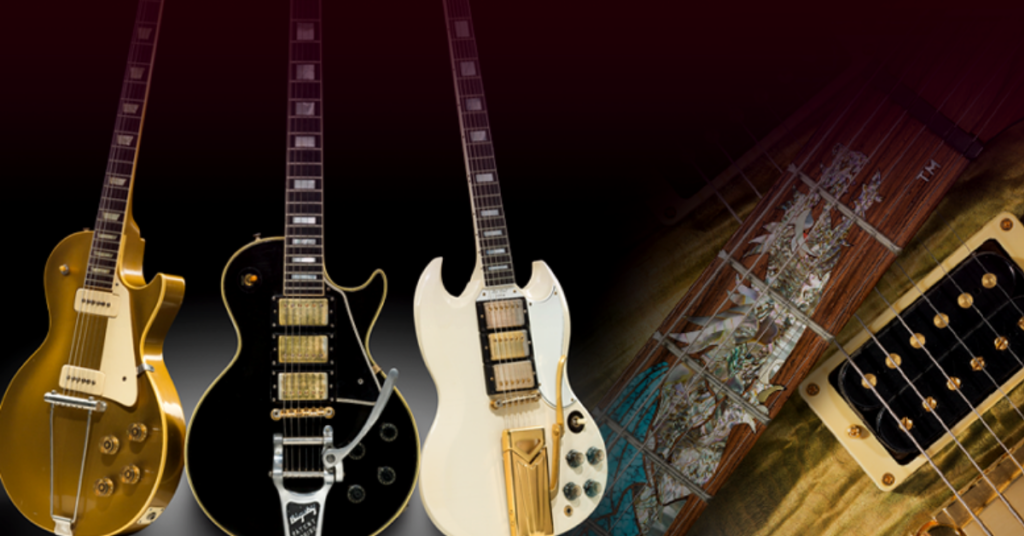
With something as subjective as a guitar, opinions can vary widely, as can the appeal one guitar can have to different people. For many, it’s more about the relationship between musician and instrument than anything else, while for others, it can be the visual aesthetic that resonates. One musician could pick up a guitar and sound like an untrained amateur, while another could deliver a virtuoso performance.
With that in mind, here are some of the guitars that stand out to our guitar experts Garry Shrum and Taylor Lewis in our upcoming Vintage Guitars & Musical Instruments Auction, which will be held March 15 in Dallas, Texas.
Garry Shrum
Director, Entertainment and Music Memorabilia
A 1957 Gibson Les Paul Custom Black Solid Body Electric Guitar is an amazing guitar in exceptional condition for being 62 years old. This Gibson guitar is an iconic one, that any enthusiast would love to have. The black hourglass body and gold-and silver-colored hardware are like your favorite pair of jeans: the appearance isn’t new, but the look is perfect, from years of use and TLC.

One of the most visually bold guitars in the auction is a 1993 Paul Reed Smith (PRS) Dragon I, Proto 6, Teal-Black Solid Body Electric Guitar. A rare and unblemished example draws attention immediately to the dragon inlay – much of which is in mother-of-pearl – that runs the entire length of the fretboard. Also notable is the dramatic flame in the wood on the front of the guitar’s body.
The back of the instrument is signed by Smith, the founder of PRS Guitars who is considered by many to be among the world’s master guitar makers.

A Circa 1968 Vox Mark VI Cherry Semi-Hollow Body Electric Guitar is a clean example of the popular Vox Teardrop guitar, but what sets this one apart from others is the rare cherry red finish. With a single cat-eye f-hole, original electronics and three saucer chrome knobs, this solid-bodied instrument is the style made famous by Brian Jones of the Rolling Stones.

Taylor Lewis
Video Production Specialist, Guitar Enthusiast and Collector
A Circa 1995 Teuffel BirdFish Blue Electric Guitar is a fascinating instrument with a futuristic appearance. Built by Ulrich Teuffel, this extreme guitar is a very early production, although no serial numbers or dates have been found on it. The electronics are in working order, and the lot includes extra tone bars and pick-ups.
What’s amazing about this instrument is that while its appearance is unquestionably unusual, it also is one of the most comfortable to play. The birdseye maple on the neck is as comfortable to play as it is beautiful. The ability to change out the wood (or “tone bars”) and pickups make this guitar as functional as it is eye-catching.

Another instrument with a look that commands attention is 1998 Jackson Roswell Rhoads Aluminum Solid Body Electric Guitar. A custom Jackson guitar, it is No. 121 in a run of just 135 made from striking aluminum. Artistic down to its smallest detail, even the volume knob is designed like a small flying saucer.
The signature style played by former Ozzie Osbourne and Quiet Riot guitarist Randy Rhodes, the instrument is simple, in both appearance and functionality, with a single pickup and volume control that makes for a no-frills playing experience. The ebony fretboard features mother-of-pearl crop circle inlays, with a unique serial number engraved into the last fret. Complete with locking tuners, the headstock is molded into a miniature version of the guitar’s body.

Maybe the most appealing feature on the 1964 Gretsch Custom Black Semi-Hollow Body Electric Guitar is the cat-eye F holes. This design was extremely rare for Gretsch guitars until the early 2000s, when they were used on the company’s “historic series.”
This guitar is one of only a couple hundred that were made, and includes the also-rare Hilo’Tron pickups which have their own unique sound compared to the Filter’Tron and Dynasonics. These single coils combine Gretsch’s iconic sparkle with the growl of a Strat or Tele. These toaster-top pickups and cat-eye soundholes make this a rare find among Gretsch guitars of this age.

The 1963 Epiphone Professional Cherry Semi-Hollow Body Electric Guitar and Amplifier is a unique guitar with a semi-hollow body that allows the sound of a hollow body while limiting feedback. With five tone switches, giving the player rare ability to control the effects within the amp – including the amp tremolo and the reverb unit – through manipulation of switches on the guitar itself, which is an extremely rare feature. The jewel light on the amp pulses at the frequency at which the trem is set.
This model was made for just six years, between 1962 and 1967. It comes with the original amp, which pairs with the guitar through a one-of-a-kind five-pin cable. Finding the original amp and guitar together makes this a rare opportunity for a player to acquire the full package.

A 2003 Bigsby BY-50T Natural Solid Body Electric Guitar is a near-new instrument in old stock condition that appears to have been played little, if at all. This instrument is one of the Gretsch-made Bigsbys that was intended for a series that never materialized – Bigsby was going to produce 12 models, but the project never happened. This guitar was modeled after the solid-body electric that Merle Travis commissioned Paul Bigsby to build in 1947.
Approximately 100 prototype guitars – one for each model, including this one – were made before the series was shut down. It features a birdseye maple top with a rosewood tailpiece, pickguard and accents. This exact guitar was featured in the Pomegranate 2012 Classic Guitars calendar with text by Robert Shaw, month of March and Electrified – The Art of the Contemporary Electric Guitar by Robert Shaw. The last true Bigsby sold at Heritage Auctions, a 1949 Bigsby Birdseye Maple Solid Body Electric Guitar, sold in 2012 for $266,500. This would be a steal for someone who wants to play or own a piece of guitar history, without breaking the bank.

Visit our Vintage Guitars department to browse auction archives and other upcoming auctions. Reach out to our experts for help valuing your instrument or if you have any questions.


I was fortunate enough to buy the “Owl” 12 string built by Božo Podunavac in the late 1970s. Contrary to what the catalog said, it was not unique, but one of three built by Božo at the time. One went to Leo Kottke (this one), one went to Peter Lang, and one went to someone else. Apparently, I got lucky, as another bidder wanted to bid higher than what I paid, but wasn’t quick enough with his internet bid. I knew Božo since 1977, although due to geography, I didn’t get to see him in person much.
Though a master craftsman, Božo never made much money. He never understood to what degree his work was appreciated. He was also a prince of a man, never arrogant about his gift.
One time, when an airline had mishandled a Božo 12-string of mine and split the neck, I asked Božo if he could repair it. He said to send it to him, so I did. Instead of repairing the neck, he made me a complete new one! He wouldn’t even take money for it, just asked if I could pay for the shipping, which I did gladly!
Thank you for your comment!
Hey Garry!
I have a very small guitar tech shop in Northern Ontario. A few years back a fellow walked in with a 1968 Les Paul Black Beauty Fretless wonder. I found a scan of the Gibson Custom shop ledger. Serial # matches, and it was shipped August 08, 1968. One of the first 3 reissues. The owner might be interested in getting it to Heritage for the March Auction. Let me know if there is an interest. There is more to the story than in this Premier Guitar Article. Cheers!
https://www.premierguitar.com/1968-gibson-les-paul-custom-reissue-black-beauty-fretless-wonder
Thank you very much Mr. Jacques. We are following up with you.